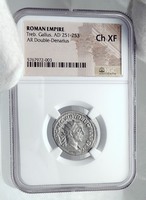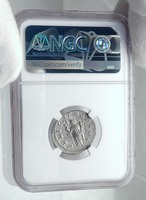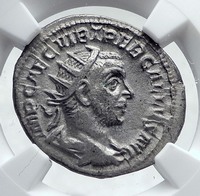Trebonianus Gallus - Roman Emperor : 251-253 A.D.
Silver Antoninianus (Double-Denarius) 22mm (3.27 grams) Ostensibly Rome mint, struck circa 251-253 A.D.
Reference: RIC 75; RSC 35a.
Certification: NGC Ancients Ch XF 5767972-003
IMP CAE C VIB TREB GALLVS AVG, Radiate, draped and cuirassed bust right.
FELICITAS PVBL, Felicitas standing facing, head left, holding caduceus and cornucopia. This type with the CAE inscription seems to be either a very scarce or even rare type. You are bidding on the exact item pictured, provided with a Certificate of Authenticity and Lifetime Guarantee of Authenticity.
In ancient Roman culture, felicitas (from the Latin adjective felix, "fruitful, blessed, happy, lucky") is a condition of divinely inspired productivity, blessedness, or happiness. Felicitas could encompass both a woman's fertility, and a general's luck or good fortune. The divine personification of Felicitas was cultivated as a goddess. Although felicitas may be translated as "good luck," and the goddess Felicitas shares some characteristics and attributes with Fortuna, the two were distinguished in Roman religion. Fortuna was unpredictable and her effects could be negative, as the existence of an altar to Mala Fortuna ("Bad Luck") acknowledges. Felicitas, however, always had a positive significance. She appears with several epithets that focus on aspects of her divine power. Felicitas had a temple in Rome as early as the mid-2nd century BC, and during the Republican era was honored at two official festivals of Roman state religion, on July 1 in conjunction with Juno and October 9 as Fausta Felicitas. Felicitas continued to play an important role in Imperial cult, and was frequently portrayed on coins as a symbol of the wealth and prosperity of the Roman Empire. Her primary attributes are the caduceus and cornucopia. The English word "felicity" derives from felicitas. As virtue or qualityIn its religious sense, felix means "blessed, under the protection or favour of the gods; happy." That which is felix has achieved the pax divom, a state of harmony or peace with the divine world. The word derives from Indo-European *dhe(i)l, meaning "happy, fruitful, productive, full of nourishment." Related Latin words include femina, "woman" (a person who provides nourishment or suckles); felo, "to suckle" in regard to an infant; filius, "son" (a person suckled); and probably fello, fellare, "to perform fellatio", with an originally non-sexual meaning of "to suck". The continued magical association of sexual potency, increase, and general good fortune in productivity is indicated by the inscription Hic habitat Felicitas ("Felicitas dwells here") on an apotropaic relief of a phallus at a bakery in Pompeii. In archaic Roman culture, felicitas was a quality expressing the close bonds between religion and agriculture. Felicitas was at issue when the suovetaurilia sacrifice conducted by Cato the Elder as censor in 184 BC was challenged as having been unproductive, perhaps for vitium, ritual error. In the following three years Rome had been plagued by a number of ill omens and prodigies (prodigia), such as severe storms, pestilence, and "showers of blood," which had required a series of expiations (supplicationes). The speech Cato gave to justify himself is known as the Oratio de lustri sui felicitate, "Speech on the Felicitas of his Lustrum", and survives only as a possible quotation by a later source. Cato says that a lustrum should be found to have produced felicitas "if the crops had filled up the storehouses, if the vintage had been abundant, if the olive oil had flowed deliberately from the groves", regardless of whatever else might have occurred. The efficacy of a ritual might be thus expressed as its felicitas. The ability to promote felicitas became proof of one's excellence and divine favor. Felicitas was simultaneously a divine gift, a quality that resided within an individual, and a contagious capacity for generating productive conditions outside oneself: it was a form of "charismatic authority". Cicero lists felicitas as one of the four virtues of the exemplary general, along with knowledge of military science (scientia rei militaris), virtus (both "valor" and "virtue"), and auctoritas, "authority." Virtus was a regular complement to felicitas, which was not thought to attach to those who were unworthy. Cicero attributed felicitas particularly to Pompeius Magnus ("Pompey the Great"), and distinguished this felicitas even from the divine good luck enjoyed by successful generals such as Fabius Maximus, Marcellus, Scipio the Younger and Marius. The sayings (sententiae) of Publilius Syrus are often attached to divine qualities, including Felicitas: "The people's Felicitas is powerful when she is merciful" (potens misericors publica est Felicitas). EpithetsEpithets of Felicitas include: - Augusta, the goddess in her association with the emperor and Imperial cult.
- Fausta ("Favored, Fortunate"), a state divinity cultivated on October 9 in conjunction with Venus Victrix and the Genius Populi Romani ("Genius" of the Roman People, also known as the Genius Publicus).
- Publica, the "public" Felicitas; that is, the aspect of the divine force that was concerned with the res publica or commonwealth, or with the Roman People (Populus Romanus).
- Temporum, the Felicitas "of the times", a title which emphasize the felicitas being experienced in current circumstances.
 Gaius Vibius Trebonianus Gallus (206 - August, 253), was Roman Emperor from 251 to 253, in a joint rule with his son Volusianus. Gaius Vibius Trebonianus Gallus (206 - August, 253), was Roman Emperor from 251 to 253, in a joint rule with his son Volusianus.
Gallus was born in Italy, in a family with respected ancestry of Etruscan senatorial background. He had two children in his marriage with Afinia Gemina Baebiana: Gaius Vibius Volusianus, later Emperor, and a daughter, Vibia Galla. His early career was a typical cursus honorum, with several appointments, both political and military. He was suffect consul and in 250 was nominated governor of the Roman province of Moesia Superior, an appointment that showed the confidence of emperor Trajan Decius in him. In Moesia, Gallus was a key figure in repelling the frequent invasion attacks by the Gothic tribes of the Danube and became popular with the army, catered to during his brief Imperial rule by his official image: military haircut, gladiatorial physique, intimidating stance (illustration, left). In June 251, Decius and his co-emperor and son Herennius Etruscus died in the Battle of Abrittus, at the hands of the Goths they were supposed to punish for raids into the empire, largely owing to the failure of Gallus to attack aggressively. When the army heard the news, the soldiers proclaimed Gallus emperor, despite Hostilian, Decius' surviving son, ascending the imperial throne in Rome. Gallus did not back down from his intention to become emperor, but accepted Hostilian as co-emperor, perhaps to avoid the damage of another civil war. While Gallus marched on Rome, an outbreak of plague struck the city and killed young Hostilian. With absolute power now in his hands, Gallus nominated his son Volusianus co-emperor. Eager to show himself competent and gain popularity with the citizens, Gallus swiftly dealt with the epidemic, providing burial for the victims. Gallus is often accused of persecuting the Christians, but the only solid evidence of this allegation is the imprisoning of Pope Cornelius in 252. Like his predecessors, Gallus did not have an easy reign. In the East, Persian Emperor Shapur I invaded and conquered the province of Syria, without any response from Rome. On the Danube, the Gothic tribes were once again on the loose, despite the peace treaty signed in 251. The army was not long pleased with the emperor, and when Aemilianus, governor of Moesia Superior and Pannonia, took the initiative of battle and defeated the Goths, the soldiers proclaimed him emperor. With a usurper threatening the throne, Gallus prepared for a fight. He recalled several legions and ordered reinforcements to return to Rome from the Rhine frontier. Despite these dispositions, Aemilianus marched onto Italy ready to fight for his claim. Gallus did not have the chance to face him in battle: he and Volusianus were murdered by their own troops in August 253, in Interamna (modern Terni).
|




 Gaius Vibius Trebonianus Gallus (206 - August, 253), was Roman Emperor from 251 to 253, in a joint rule with his son Volusianus.
Gaius Vibius Trebonianus Gallus (206 - August, 253), was Roman Emperor from 251 to 253, in a joint rule with his son Volusianus.
